Indonesia Rice Irrigation System: Time for Innovation
Abstract
1. Introduction
2. Study Area
3. Indonesia’s Rice Irrigation System
3.1. History of Irrigation System and Irrigation Infrastructure Development in Indonesia
3.2. Irrigation Community and Policy Reforms in Indonesia’s Irrigation Systems
4. Challenges to the Indonesia Irrigation System
4.1. Dynamics of Rice Production in Indonesia
4.2. Contribution of Rice Production to Green House Gas (GHG) Emission
4.3. Threat of Climate Change to Rice Production and Irrigation System in Indonesia
5. Proposed Solutions for the Future Irrigation System in Indonesia
5.1. Irrigation Modernization in Indonesia
5.2. Improve Communities’ Involvement in Tackling Irrigation and Climate Change Issues through Incentive-Based Policies
5.3. Strengthen Local Institutions and Communities Support for Irrigation
5.4. Biotechnology, Upland Rice Field, and Improved Research
6. Conclusions
Author Contributions
Funding
Institutional Review Board Statement
Informed Consent Statement
Data Availability Statement
Acknowledgments
Conflicts of Interest
References
- Food and Agriculture Organization of the United Nations. Review of World Water Resources by Country; FAO: Rome, Italy, 2003; ISBN 92-5-104899-1. [Google Scholar]
- Dharma, A. Development of Water Rersources Policy and Its Effect on Irrigation Management; Fakultas Teknik Sipil dan Perencanaan, Universitas Gunadarma: Depok City, Indonesia, 2013. (In Indonesian) [Google Scholar]
- Fulazzaky, M.A. Challenges of Integrated Water Resources Management in Indonesia. Water 2014, 6, 2000–2020. [Google Scholar] [CrossRef]
- AQUASTAT. AQUASTAT—FAO’s Global Information System on Water and Agriculture. Available online: https://www.fao.org/aquastat/en/databases/maindatabase (accessed on 17 September 2022).
- World Bank. Indonesia Public Expenditure Review 2020: Spending for Better Results; World Bank: Washington, DC, USA, 2020. [Google Scholar]
- Indonesia Water Use, Resources and Precipitation—Worldometer. Available online: https://www.worldometers.info/water/indonesia-water/ (accessed on 12 August 2022).
- World Bank Agriculture, Forestry, and Fishing, Value Added (% of GDP)—Indonesia. Available online: https://data.worldbank.org/indicator/NV.AGR.TOTL.ZS?locations=ID (accessed on 8 August 2022).
- Employment in Agriculture (% of Total Employment) (Modeled ILO Estimate)—Indonesia. Available online: https://data.worldbank.org/indicator/SL.AGR.EMPL.ZS?locations=ID (accessed on 12 August 2022).
- Agricultural Land (Sq. Km)—Indonesia. Available online: https://data.worldbank.org/indicator/AG.LND.AGRI.K2?locations=ID (accessed on 12 August 2022).
- Indonesia Statistical Agency. Available online: https://www.bps.go.id/publication/2021/02/26/938316574c78772f27e9b477/statistik-indonesia-2021.html (accessed on 8 August 2022). (In Indonesian).
- Hanjra, M.A.; Qureshi, M.E. Global Water Crisis and Future Food Security in an Era of Climate Change. Food Policy 2010, 35, 365–377. [Google Scholar] [CrossRef]
- FAOSTAT. Available online: https://www.fao.org/faostat/en/#data (accessed on 11 August 2022).
- Soenarno, S. Is Irrigation Sustainable? The Indonesian Perspective. Can. Water Resour. J. 1993, 18, 281–290. [Google Scholar] [CrossRef]
- Panuju, D.R.; Mizuno, K.; Trisasongko, B.H. The Dynamics of Rice Production in Indonesia 1961–2009. J. Saudi Soc. Agric. Sci. 2013, 12, 27–37. [Google Scholar] [CrossRef]
- Widiana, A.; Wijaya, C.; Atmoko, A.W. The Challenges of Food Security Policy in Indonesia: Lesson Learned from Vietnam, India, and Japan. Tech. Soc. Sci. J. 2022, 33, 1–15. [Google Scholar] [CrossRef]
- Azdan, D. Overview of Indonesia Water System and Policies. In Proceedings of the Workshop Sustainable Water Management for Agriculture, Organized by the Ministry of Agriculture, Jakarta, Indonesia, 13 December 2011; Volume 13, pp. 1–15. [Google Scholar]
- Hussain, I.; Hanjra, M.A. Irrigation and Poverty Alleviation: Review of the Empirical Evidence. Irrig. Drain. 2004, 53, 1–15. [Google Scholar] [CrossRef]
- Huang, Q.; Rozelle, S.; Lohmar, B.; Huang, J.; Wang, J. Irrigation, Agricultural Performance and Poverty Reduction in China. Food Policy 2006, 31, 30–52. [Google Scholar] [CrossRef]
- Rizal, A.; Rochima, E.; Rahmatunnisa, M.; Muljana, B. Impact of Irrigation on Agricultural Growth and Poverty Alleviation in West Java Province, Indonesia. World Sci. News 2021, 151, 64–77. [Google Scholar]
- Bacha, D.; Namara, R.; Bogale, A.; Tesfaye, A. Impact of Small-Scale Irrigation on Household Poverty: Empirical Evidence from the Ambo District in Ethiopia. Irrig. Drain. 2011, 60, 1–10. [Google Scholar] [CrossRef]
- Carruthers, I.; Rosegrant, M.W.; Seckler, D. Irrigation and Food Security in the 21st Century. Irrig. Drain. Syst. 1997, 11, 83–101. [Google Scholar] [CrossRef]
- Darko, R.O.; Yuan, S.; Hong, L.; Liu, J.; Yan, H. Irrigation, a Productive Tool for Food Security—A Review. Acta Agric. Scand. Sect. B Soil Plant Sci. 2016, 66, 191–206. [Google Scholar] [CrossRef]
- Kesuma, S.I.; Maryunianta, Y.; Muda, I. Evaluation of Irrigation System to Support Implementation of Food Security Policy. Int. J. Civ. Eng. Technol. 2018, 9, 600–614. [Google Scholar]
- Deribie, M. Impact of Akaki Small-Scale Irrigation Scheme on Household Food Security. Master’s Thesis, St. Mary’s University, Addis Ababa, Ethiopia, December 2015. [Google Scholar]
- Bagson, E.; Kuuder, C.-J.W. Assessment of A Smallscale Irrigation Scheme on Household Food Security and Leisure in Kokoligu; Ghana. Res. Humanit. Soc. Sci. 2013, 3, 17–26. [Google Scholar]
- Amede, T.; Awulachew, S.B.; Matti, B.; Yitayew, M. Managing Rainwater for Resilient Dryland Systems in Sub-Saharan Africa: Review of Evidences. In Nile River Basin: Ecohydrological Challenges, Climate Change and Hydropolitics; Melesse, A.M., Abtew, W., Setegn, S.G., Eds.; Springer International Publishing: Cham, Switzerland, 2014; pp. 517–540. ISBN 978-3-319-02720-3. [Google Scholar]
- Hussain, I.; Wijerathna, D.; Arif, S.S.; Mawarni, A. Suparmi Irrigation, Productivity and Poverty Linkages in Irrigation Systems in Java, Indonesia. Water Resour. Manag. 2006, 20, 313–336. [Google Scholar] [CrossRef]
- Hussain, I. Poverty in Irrigated Agriculture: Realities, Issues, and Options with Guidelines; International Water Management Institute: Colombo, Sri Lanka, 2004; p. 124. [Google Scholar]
- Lien Damayanti, S. The Effect of Irrigation on Employment Opportunities, Poverty and Food Security of Farmers’ Households in the Parigi Moutong Irrigation Area; Universitas Gadjah Mada: Yogyakarta, Indonesia, 2012. (In Indonesian) [Google Scholar]
- Indonesia Statistical Agency. Available online: https://www.bps.go.id/statictable/2017/02/08/1959/jumlah-curah-hujan-dan-jumlah-hari-hujan-di-stasiun-pengamatan-bmkg-2011-2015.html (accessed on 16 September 2022).
- Hidayat, R.; Juniarti, M.D.; Ma’rufah, U. Impact of La Niña and La Niña Modoki on Indonesia Rainfall Variability. IOP Conf. Ser. Earth Environ. Sci. 2018, 149, 012046. [Google Scholar] [CrossRef]
- Hamada, J.-I.; Mori, S.; Kubota, H.; Yamanaka, M.D.; Haryoko, U.; Lestari, S.; Sulistyowati, R.; Syamsudin, F. Interannual Rainfall Variability over Northwestern Jawa and Its Relation to the Indian Ocean Dipole and El Niño-Southern Oscillation Events. Sola 2012, 8, 69–72. [Google Scholar] [CrossRef]
- Water Management—IRRI Rice Knowledge Bank. Available online: http://www.knowledgebank.irri.org/step-by-step-production/growth/water-management (accessed on 18 September 2022).
- Syuaib, M.F. Sustainable Agriculture in Indonesia: Facts and Challenges to Keep Growing in Harmony with Environment. Agric. Eng. Int. CIGR J. 2016, 18, 170–184. [Google Scholar]
- Lansing, J.S.; Kremer, J.N. Emergent Properties of Balinese Water Temple Networks: Coadaptation on a Rugged Fitness Landscape. Am. Anthropol. 1993, 95, 97–114. [Google Scholar] [CrossRef]
- Booth, A. Irrigation in Indonesia Part. Bull. Indones. Econ. Stud. 1977, 13, 33–74. [Google Scholar] [CrossRef]
- Mabry, J.B. Canals and Communities: Small-Scale Irrigation Systems; University of Arizona Press: Tuscon, AR, USA, 1996; ISBN 978-0-8165-1592-9. [Google Scholar]
- Publication of Ministry of National. Development Planning of the Republic of Indonesia. Available online: https://www.bappenas.go.id/datapublikasishow?q=Rencana%20Pembangunan%20dan%20Rencana%20Kerja%20Pemerintah (accessed on 11 August 2022).
- Pasandaran, E. Hystorical Perspective of Irrigation Management in Indonesia Toward A New Wave of Development. In Proceeding of the t ICID—CIID Seminar on “History of Irrigation in Eastern Asia”, Yogyakarta, Indonesia, 13 October 2010; p. 17. [Google Scholar]
- Ravesteijn, W. Dutch Engineering Overseas: The Creation of a Modern Irrigation System in Colonial Java. Knowl. Technol. Policy 2002, 14, 126–144. [Google Scholar] [CrossRef]
- Van der Eng, P. Food Supply in Java during War and Decolonisation, 1940–1950. Available online: https://mpra.ub.uni-muenchen.de/8852/ (accessed on 4 August 2022).
- Pasandaran, E. Irrigation Reform in the Framework of Integrated Water Resources Management. Anal. Kebijak. Pertan. 2005, 3, 19. (In Indonesian) [Google Scholar]
- Elson, R.E. The Famine in Demak and Grobogan -Java- in 1849/ 50: Its Causes and Circumstances. Rev. Indones. Malays. Aff. 1985, 19, 39–85. [Google Scholar] [CrossRef]
- Ravesteijn, W. Controlling Water, Controlling People: Irrigation Engineering and State Formation in the Dutch East Indies. Itinerario 2007, 31, 89–118. [Google Scholar] [CrossRef]
- Gany, A.H.A. An Outlook of Infrastructural Heritages of Irrigation in Indonesia. In Proceeding of the 61st IEC and the 6th Asian Regional Conference of ICID in Yogyakarta, Yogyakarta, Indonesia, 13 October 2010; p. 14. [Google Scholar]
- Wulandari, D.S. Irrigation in Afdeeling Bondowoso in the 1880s to 1920s. Master’s Thesis, Universitas Airlangga, Surabaya, Indonesia, 2020. (In Indonesian). [Google Scholar]
- Thompson, D.F. Political Ethics. In International Encyclopedia of Ethics; Lafollette, H., Ed.; Blackwell Publishing Ltd.: Oxford, UK, 2013; p. wbiee633. ISBN 978-1-4051-8641-4. [Google Scholar]
- van Zanden, J.L. Rich and Poor before the Industrial Revolution: A Comparison between Java and the Netherlands at the Beginning of the 19th Century. Explor. Econ. Hist. 2003, 40, 1–23. [Google Scholar] [CrossRef]
- Andersson, M.; Axelsson, T.; Palacio, A. Resilience to Economic Shrinking in an Emerging Economy: The Role of Social Capabilities in Indonesia, 1950–2015. J. Inst. Econ. 2021, 17, 509–526. [Google Scholar] [CrossRef]
- Lassa, J.A. Understanding Indonesia’s Food and Nutrition Policy: A Case Study of East Nusa Tenggara 1958–2008. J. NTT Stud. 2009, 1, 28–45. (In Indonesian) [Google Scholar]
- Nawiyanto. The End of the Agricultural Front: A Historical Study of the Besuki Region, 1870–1970. J. Masy. Dan Budaya 2012, 14, 77–98. (In Indonesian) [Google Scholar]
- Pasandaran, E. Highlighting the History of the Development of Laws on Irrigation Water and Water Resources. Forum Penelit. Agro Ekon. 2015, 33, 33. [Google Scholar] [CrossRef]
- Simandjuntak, D.S. The Indonesian Economy in 1986: Under the Shadow of a Weakening Oil Market. Southeast Asian Aff. 1987, 146–157. Available online: https://www.jstor.org/stable/27908573 (accessed on 18 August 2022). [CrossRef]
- Istijono, B.; Ophiyandri, T. Community-Based Approach in A Small Scale Irrigation Project in Indonesia: Ways and Advantages. Civ. Eng. Dimens. 2015, 17, 95–100. [Google Scholar] [CrossRef][Green Version]
- Ertsen, M.W. Prescribing Perfection. Emergence of an Engineering Irrigation Design Approach in the Netherlands East Indies and Its Legacy, 1830–1990. Ph.D. Thesis, Faculty of Civil Engineering and Geosciences, Delft, The Netherlands, 25 October 2005. [Google Scholar]
- Ravesteijn, W. Between Globalization and Localization: The Case of Dutch Civil Engineering in Indonesia, 1800–1950. Comp. Technol. Transf. Soc. 2007, 5, 32–64. [Google Scholar] [CrossRef]
- Idris, A.M.S.; Juari; Saleh, M.I.; Hazet, F.A.; Sianturi, U.M.; Wananda, B.R.; Taufani, A.R.; Kurniawan, A.; Josiana, R.M.; Pratiwi, A.; et al. Single Management Irrigation. 2019. Available online: https://kkp.go.id/an-component/media/upload-gambar-pendukung/DitJaskel/publikasi%20materi/smi/1.%20Policy%20Paper%20Pengelolaan%20Satu%20Kesatuan%20Sistem%20Irigasi%20(Single%20Management%20Irrigation).pdf (accessed on 16 September 2022).
- Boomgaard, P. In the Shadow of Rice: Roots and Tubers in Indonesian History, 1500–1950. Agric. Hist. 2003, 77, 582–610. [Google Scholar] [CrossRef]
- Fuglie, K.O. Productivity Growth in Indonesian Agriculture, 1961–2000. Bull. Indones. Econ. Stud. 2004, 40, 209–225. [Google Scholar] [CrossRef][Green Version]
- Hartini, T.N.S.; Padmawati, R.S.; Lindholm, L.; Surjono, A.; Winkvist, A. The Importance of Eating Rice: Changing Food Habits among Pregnant Indonesian Women during the Economic Crisis. Soc. Sci. Med. 2005, 61, 199–210. [Google Scholar] [CrossRef] [PubMed]
- Santoso, M. Inventory of damage to irrigation Mataram in the province of the Special Region of Yogyakarta. Undergraduate Thesis, University of Technology Yogyakarta, Yogyakarta, Indonesia, 2017. (In Indonesian). [Google Scholar]
- Februarman, FTypes and varieties of damage to primary canals in the Bandar Laweh irrigation area, Solok Regency. J. Rekayasa Sipil JRS-Unand 2015, 5, 57–66. (In Indonesian) [CrossRef]
- Pravitasari, A.E.; Suhada, A.; Mulya, S.P.; Rustiadi, E.; Murtadho, A.; Wulandari, S.; Widodo, C.E. Land Use/Cover Changes and Spatial Distribution Pattern of Rice Field Decreasing Trend in Serang Regency, Banten Province. IOP Conf. Ser. Earth Environ. Sci. 2019, 399, 012033. [Google Scholar] [CrossRef]
- Firman, T. Land Conversion and Urban Development in the Northern Region of West Java, Indonesia. Urban Stud. 1997, 34, 1027–1046. [Google Scholar] [CrossRef]
- Siagian, D.R.; Shrestha, R.P.; Shrestha, S.; Kuwornu, J.K.M. Factors Driving Rice Land Change 1989–2018 in the Deli Serdang Regency, Indonesia. Agriculture 2019, 9, 186. [Google Scholar] [CrossRef]
- Thorp, K.R.; Drajat, D. Deep Machine Learning with Sentinel Satellite Data to Map Paddy Rice Production Stages across West Java, Indonesia. Remote Sens. Environ. 2021, 265, 112679. [Google Scholar] [CrossRef]
- Rosegrant, M.W.; Cai, X.; Cline, S.A. Water and Food to 2025: Policy Responses to the Threat of Scarcity; International Food Policy Research Institute (IFPRI); International Water Management Institute (IWMI): Washington, DC, USA, 2002; p. 6. [Google Scholar]
- Octania, G. The Government’s Role in Indonesia’s Rice Supply Chain. 2021. Available online: https://repository.cips-indonesia.org/ms/publications/338076/ (accessed on 8 April 2022).
- Wang, C.; Lai, D.Y.F.; Sardans, J.; Wang, W.; Zeng, C.; Peñuelas, J. Factors Related with CH4 and N2O Emissions from a Paddy Field: Clues for Management Implications. PLoS ONE 2017, 12, e0169254. [Google Scholar] [CrossRef]
- Forster, P.; Ramaswamy, V.; Artaxo, P.; Berntsen, T.; Betts, R.; Fahey, D.W.; Haywood, J.; Lean, J.; Lowe, D.C.; Raga, G.; et al. Changes in Atmospheric Constituents and in Radiative Forcing. In Climate Change 2007: The Physical Science Basis; Cambridge University Press: Cambridge, UK, USA, 2007; p. 106. [Google Scholar]
- Epule, E.T.; Peng, C.; Mafany, N.M. Methane Emissions from Paddy Rice Fields: Strategies towards Achieving A Win-Win Sustainability Scenario between Rice Production and Methane Emission Reduction. J. Sustain. Dev. 2011, 4, p188. [Google Scholar] [CrossRef]
- Haefele, S.M.; Kato, Y.; Singh, S. Climate Ready Rice: Augmenting Drought Tolerance with Best Management Practices. Field Crops Res. 2016, 190, 60–69. [Google Scholar] [CrossRef]
- Zhang, Z.; Furman, A. Soil Redox Dynamics under Dynamic Hydrologic Regimes—A Review. Sci. Total Environ. 2021, 763, 143026. [Google Scholar] [CrossRef] [PubMed]
- Wassmann, R.; Neue, H.U.; Lantin, R.S.; Makarim, K.; Chareonsilp, N.; Buendia, L.V.; Rennenberg, H. Characterization of Methane Emissions from Rice Fields in Asia. II. Differences among Irrigated, Rainfed, and Deepwater Rice. In Methane Emissions from Major Rice Ecosystems in Asia; Wassmann, R., Lantin, R.S., Neue, H.-U., Eds.; Developments in Plant and Soil Sciences; Springer: Dordrecht, The Netherlands, 2000; pp. 13–22. ISBN 978-94-010-0898-3. [Google Scholar]
- Jaramillo, S.; Graterol, E.; Pulver, E. Sustainable Transformation of Rainfed to Irrigated Agriculture Through Water Harvesting and Smart Crop Management Practices. Front. Sustain. Food Syst. 2020, 4, 437086. [Google Scholar] [CrossRef]
- Timmer, C.P. The Political Economy of Rice in Asia: Indonesia. Food Res. Inst. Stud. 1975, 14, 197–231. [Google Scholar]
- Riyanto, H.; Adriati, I. Kultur Padi; Sutrisno, S., Ed.; Museum Nasional: Jakarta, Indonesia, 2001. [Google Scholar]
- The Function of the Myth of the Origin of Rice of the Dayak Bidayuh People in West Kalimantan. Jantra. Available online: http://jantra.kemdikbud.go.id/index.php/jantra/article/view/84 (accessed on 18 September 2022).
- Irawati, N. Analysis of Rice Farmers’ Attitudes and Satisfaction with Superior Rice Seeds (Oryza Sativa) in Solok City, West Sumatra. Undergraduate Thesis, IPB University, Bogor, Indonesia, 2009. (In Indonesian). [Google Scholar]
- Survival strategies for small farmers in Sindetlami Village, Besuk District, Probolinggo Regency. Jurnal Pendidikan Ekonomi: Jurnal Ilmiah Ilmu Pendidikan, Ilmu Ekonomi Dan Ilmu Sosial. Available online: http://jurnal.unej.ac.id/index.php/JPE/article/view/3373 (accessed on 18 September 2022). (In Indonesian).
- Gellert, P.K. A Brief History and Analysis of Indonesia’s Forest Fire Crisis. In Indonesia; Cornell University Press: Ithaca, NY, USA, 1998; pp. 63–85. [Google Scholar] [CrossRef]
- Jim, C.Y. The Forest Fires in Indonesia 1997–1998: Possible Causes and Pervasive Consequences. Geography 1999, 84, 251–260. [Google Scholar]
- Cooper, R.N.; Houghton, J.T.; McCarthy, J.J.; Metz, B. Climate Change 2001: The Scientific Basis. Foreign Aff. 2002, 81, 208. [Google Scholar] [CrossRef]
- Yang, S.; Peng, S.; Xu, J.; Luo, Y.; Li, D. Methane and Nitrous Oxide Emissions from Paddy Field as Affected by Water-Saving Irrigation. Phys. Chem. Earth Parts ABC 2012, 53–54, 30–37. [Google Scholar] [CrossRef]
- Cai, Z.; Xing, G.; Yan, X.; Xu, H.; Tsuruta, H.; Yagi, K.; Minami, K. Methane and Nitrous Oxide Emissions from Rice Paddy Fields as Affected by Nitrogen Fertilisers and Water Management. Plant Soil 1997, 196, 7–14. [Google Scholar] [CrossRef]
- Granli, T.; Bockman, O.C. Nitrous Oxide from Agriculture; Wageningen Environmental Research: Wageningen, The Netherlands, 1994. [Google Scholar]
- Zhou, M.; Zhu, B.; Wang, X.; Wang, Y. Long-Term Field Measurements of Annual Methane and Nitrous Oxide Emissions from a Chinese Subtropical Wheat-Rice Rotation System. Soil Biol. Biochem. 2017, 115, 21–34. [Google Scholar] [CrossRef]
- Lan, T.; Li, M.; Han, Y.; Deng, O.; Tang, X.; Luo, L.; Zeng, J.; Chen, G.; Yuan, S.; Wang, C.; et al. How Are Annual CH4, N2O, and NO Emissions from Rice–Wheat System Affected by Nitrogen Fertilizer Rate and Type? Appl. Soil Ecol. 2020, 150, 103469. [Google Scholar] [CrossRef]
- Hua, X.; Guangxi, X.; Cai, Z.-C.; Tsuruta, H. Nitrous Oxide Emissions from Three Rice Paddy Fields in China. Nutr. Cycl. Agroecosystems 1997, 49, 23–28. [Google Scholar] [CrossRef]
- Nishimura, S.; Akiyama, H.; Sudo, S.; Fumoto, T.; Cheng, W.; Yagi, K. Combined Emission of CH4 and N2O from a Paddy Field Was Reduced by Preceding Upland Crop Cultivation. Soil Sci. Plant Nutr. 2011, 57, 167–178. [Google Scholar] [CrossRef]
- Akiyama, H.; Yagi, K.; Yan, X. Direct N2O Emissions from Rice Paddy Fields: Summary of Available Data. Glob. Biogeochem. Cycles 2005, 19, GB1005. [Google Scholar] [CrossRef]
- Mid-Season Rice Paddy Drainage. UNCCD. Available online: https://www.unccd.int/best-practice/mid-season-rice-paddy-drainage (accessed on 18 September 2022).
- Kroeze, C.; Mosier, A.; Nevison, C.; Oenema, O.; Seitzinger, S.; Cleemput, O.; van Conrad, R.; Mitra, A.P.; Neue, H.U.; Sass, R. Revised 1996 IPCC Guidelines for National Greenhouse Gas Inventories: Chapter 4. Agriculture; IPPC: Rome, Italy, 1997. [Google Scholar]
- Irawan, B. Dynamics of Lowland and Upland Rice Production: Implications for Policy to Increase Rice Production. Available online: http://www.litbang.pertanian.go.id/buku/swasembada (accessed on 4 August 2022). (In Indonesian).
- Naylor, R.L.; Battisti, D.S.; Vimont, D.J.; Falcon, W.P.; Burke, M.B. Assessing Risks of Climate Variability and Climate Change for Indonesian Rice Agriculture. Proc. Natl. Acad. Sci. USA 2007, 104, 7752–7757. [Google Scholar] [CrossRef]
- Hukom, E.; Limantara, L.M.; Andawayanti, U. The Effect of Climate Change on Optimization of Water Availability in Way Mital Irrigation, Maluku Province. J. Tek. Pengair. J. Water Resour. Eng. 2012, 3, 24–32. [Google Scholar]
- Yamane, I.; Sato, K. Decomposition of Plant Constituents and Gas Formation in Flooded Soil. Soil Sci. Plant Nutr. 1963, 9, 28–31. [Google Scholar] [CrossRef]
- Arif, S.S.; Pradipta, A.G.; Subekti, E.; Prabowo, A.; Sidharti, T.S.; Soekarno, I.; Fatah, Z. Toward Modernization of Irrigation from Concept to Implementations: Indonesia Case. IOP Conf. Ser. Earth Environ. Sci. 2019, 355, 012024. [Google Scholar] [CrossRef]
- Vermillion, D.L.; Lengkong, S.R.; Atmanto, S.D. Time for Innovation in Indonesia’s Irrigation Sector. Available online: https://www.oecd.org/greengrowth/sustainable-agriculture/49175235.pdf (accessed on 8 April 2022).
- Kahil, M.T.; Connor, J.D.; Albiac, J. Efficient Water Management Policies for Irrigation Adaptation to Climate Change in Southern Europe. Ecol. Econ. 2015, 120, 226–233. [Google Scholar] [CrossRef]
- Wangiyana, W.; Dulur, N.W.D.; Farida, N.; Kusnarta, I.G.M. Additive Intercropping with Peanut Relay-Planted between Different Patterns of Rice Rows Increases Yield of Red Rice in Aerobic Irrigation System. Emir. J. Food Agric. 2021, 33, 202–210. [Google Scholar] [CrossRef]
- Setyanto, P.; Pramono, A.; Adriany, T.A.; Susilawati, H.L.; Tokida, T.; Padre, A.T.; Minamikawa, K. Alternate Wetting and Drying Reduces Methane Emission from a Rice Paddy in Central Java, Indonesia without Yield Loss. Soil Sci. Plant Nutr. 2018, 64, 23–30. [Google Scholar] [CrossRef]
- Jumadi, O.; Ali, A.; Hala, Y.; Muis, A.; Yagi, K.; Inubushi, K. Effect of Controlled Water Level on CH4 and N2O Emissions from Rice Fields in Indonesia. Trop. Agric. Dev. 2012, 56, 129–138. [Google Scholar] [CrossRef]
- Searchinger, T.; Waite, R. More Rice, Less Methane. 2014. Available online: https://www.wri.org/insights/more-rice-less-methane (accessed on 12 August 2022).
- Sass, R.L.; Fisher, F.M.; Wang, Y.B.; Turner, F.T.; Jund, M.F. Methane Emission from Rice Fields: The Effect of Floodwater Management. Glob. Biogeochem. Cycles 1992, 6, 249–262. [Google Scholar] [CrossRef]
- Minister of Environment and Forestry Decree Operational Plan. Indonesia’s FOLUS Net Sink 2030. Available online: https://www.menlhk.go.id/uploads/site/post/1647334063.pdf (accessed on 18 September 2022).
- Qureshi, M.E.; Schwabe, K.; Connor, J.; Kirby, M. Environmental Water Incentive Policy and Return Flows: Water Incentive Policy and Return Flows. Water Resour. Res. 2010, 46, W04517. [Google Scholar] [CrossRef]
- Suhaeti, R.N.; Saleh, A.; Abbas, A. Factors on Community Investment-Based Small Scale Irrigation Development in Indonesia: Case of West Nusa Tenggara. Sodality J. Sosiol. Pedesaan 2018, 6. [Google Scholar] [CrossRef]
- Ambler, J.S. “Adat” and Aid: Management of Small-Scale Irrigation in West Sumatra, Indonesia. Ph.D. Thesis, Cornell University, Ithaca, NY, USA, 1988. [Google Scholar]
- Pasaribu, S.M.; Routray, J.K. Performance of Farmer-Managed Irrigation Systems for Rice Production in East Java Province, Indonesia. Int. J. Water Resour. Dev. 2005, 21, 473–491. [Google Scholar] [CrossRef]
- AR5 Climate Change 2014: Impacts, Adaptation, and Vulnerability; IPCC: Geneva, Switzerland, 2014.
- Wang, J.; Huang, J.; Zhang, L.; Huang, Q. Do Incentives Still Matter for the Reform of Irrigation Management in the Yellow River Basin in China? J. Hydrol. 2014, 517, 584–594. [Google Scholar] [CrossRef]
- Ostrom, E. Beyond Markets and States: Polycentric Governance of Complex Economic Systems. Am. Econ. Rev. 2010, 100, 641–672. [Google Scholar] [CrossRef]
- Arif, S.S.; Prabowo, A.; Djito, D. Development of the Concept of Operation and Maintenance (O&M) System for Multipurpose Irrigation Areas by Building a Commitment to Consensus Between Actors: A Case in East Java. J. Sos. Ekon. Pertan. 2007, 7, 15. (In Indonesian) [Google Scholar]
- Sivapalan, M.; Savenije, H.H.G.; Blöschl, G. Socio-Hydrology: A New Science of People and Water. Hydrol. Process. 2012, 26, 1270–1276. [Google Scholar] [CrossRef]
- Gunda, T.; Turner, B.L.; Tidwell, V.C. The Influential Role of Sociocultural Feedbacks on Community-Managed Irrigation System Behaviors During Times of Water Stress. Water Resour. Res. 2018, 54, 2697–2714. [Google Scholar] [CrossRef]
- Arif, S.S. Future Irrigation Operation and Maintenance (O&M) An Idea Anticipating Policy and Environmental Changes. agriTECH 2006, 26. (In Indonesian) [Google Scholar] [CrossRef]
- World Bank. World Development Report 1994: Infrastructure for Development; World Bank: Washington, DC, USA, 1994. [Google Scholar]
- Chai, Y.; Schoon, M. Institutions and Government Efficiency: Decentralized Irrigation Management in China. Int. J. Commons 2016, 10, 21–44. [Google Scholar] [CrossRef][Green Version]
- Indonesia Statistical Agency. Available online: https://www.bps.go.id/statictable/2019/04/10/2055/nilai-produksi-dan-biaya-produksi-per-musim-tanam-per-hektar-budidaya-tanaman-padi-sawah-padi-ladang-jagung-dan-kedelai-2017.html (accessed on 12 August 2022).
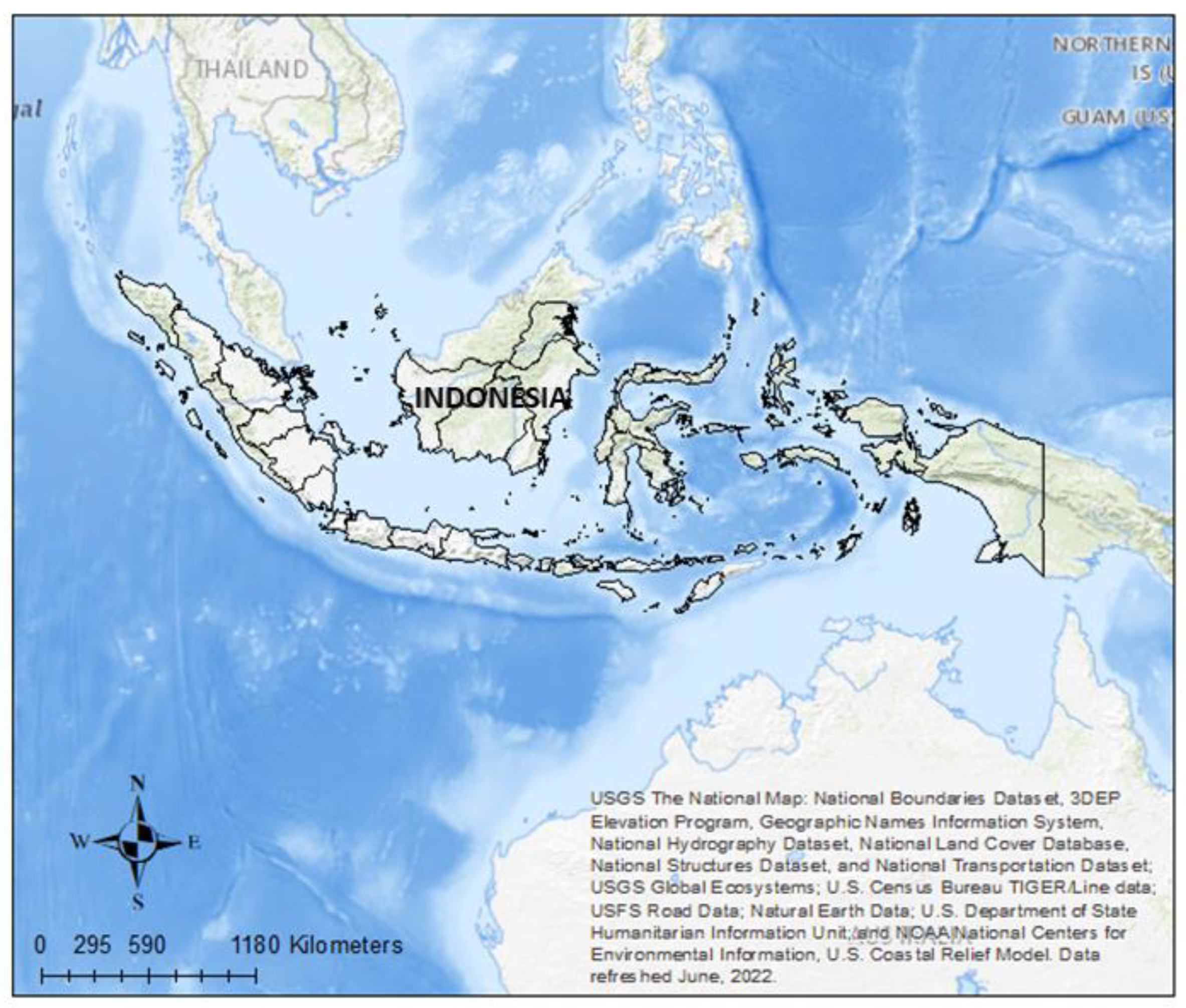
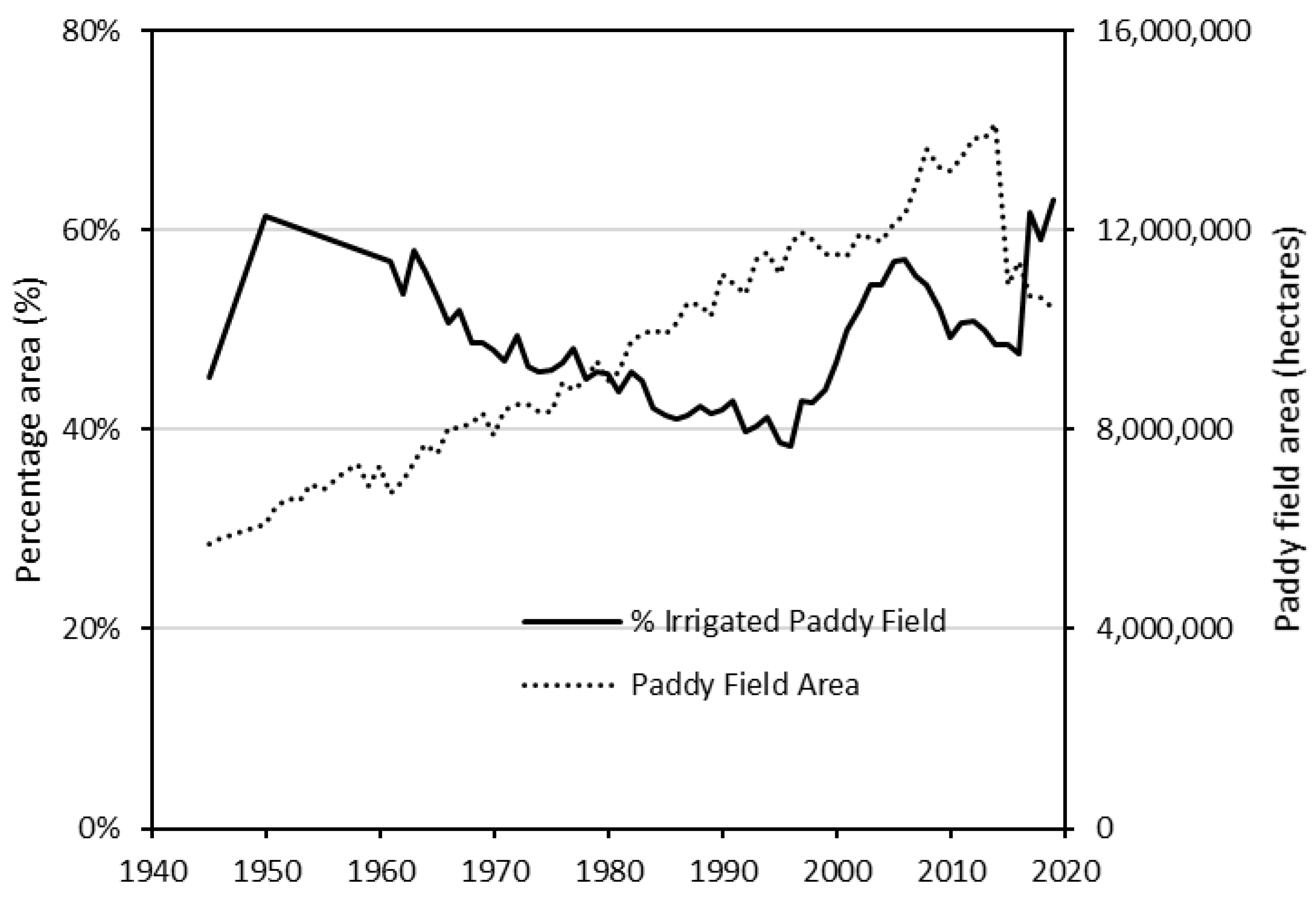

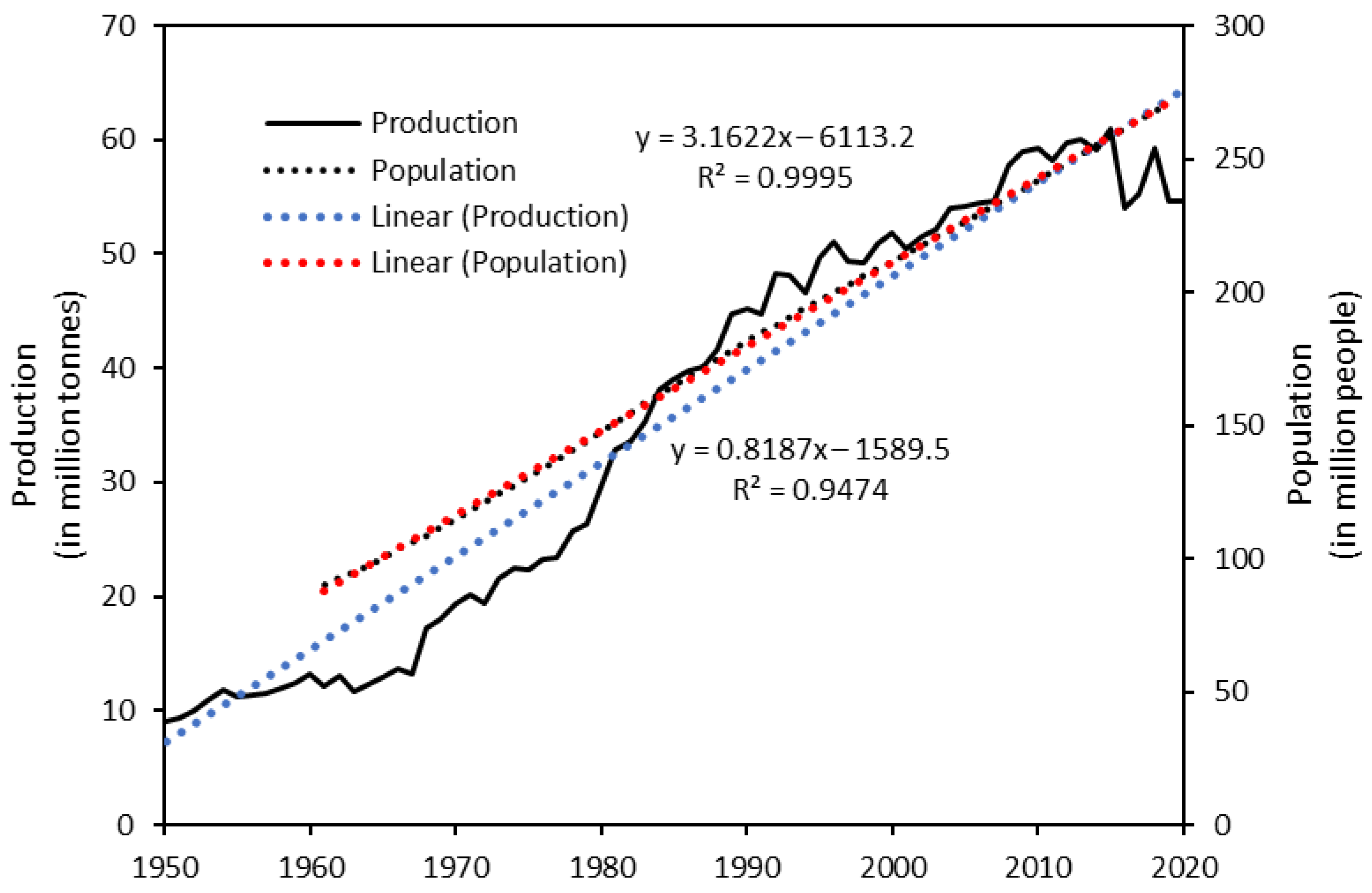
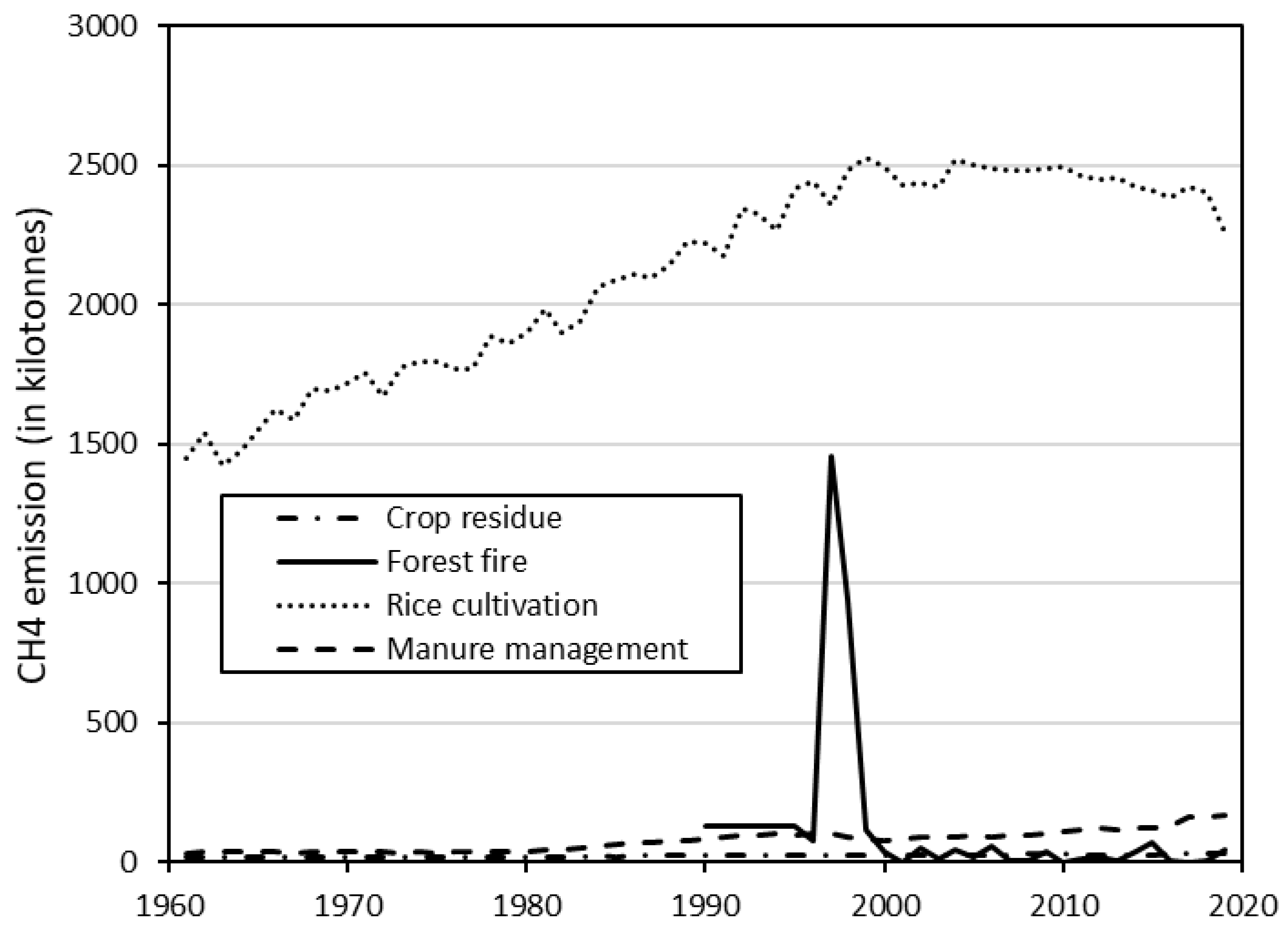
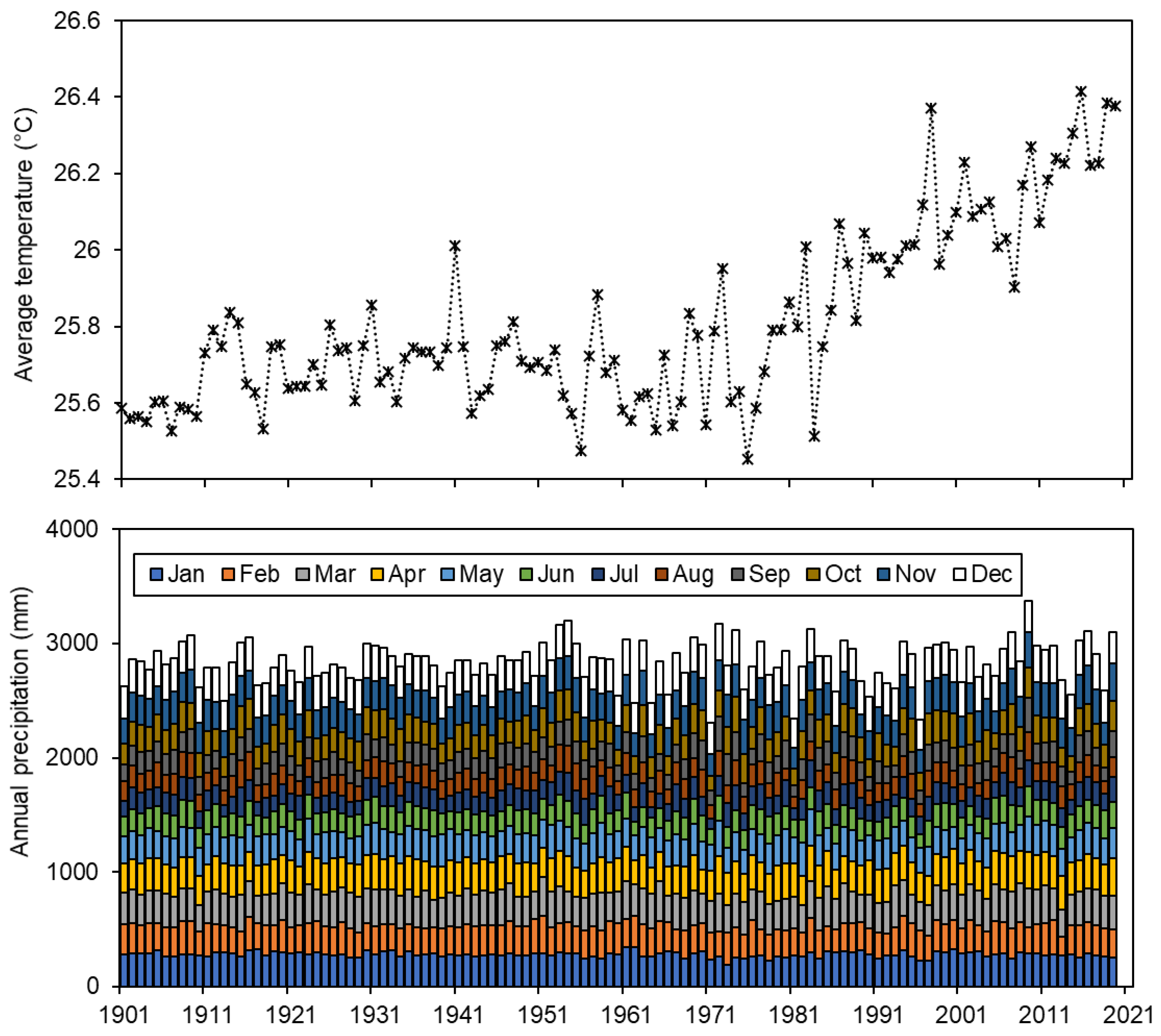
Publisher’s Note: MDPI stays neutral with regard to jurisdictional claims in published maps and institutional affiliations. |
© 2022 by the authors. Licensee MDPI, Basel, Switzerland. This article is an open access article distributed under the terms and conditions of the Creative Commons Attribution (CC BY) license (https://creativecommons.org/licenses/by/4.0/).
Share and Cite
Tirtalistyani, R.; Murtiningrum, M.; Kanwar, R.S. Indonesia Rice Irrigation System: Time for Innovation. Sustainability 2022, 14, 12477. https://doi.org/10.3390/su141912477
Tirtalistyani R, Murtiningrum M, Kanwar RS. Indonesia Rice Irrigation System: Time for Innovation. Sustainability. 2022; 14(19):12477. https://doi.org/10.3390/su141912477
Chicago/Turabian StyleTirtalistyani, Rose, Murtiningrum Murtiningrum, and Rameshwar S. Kanwar. 2022. "Indonesia Rice Irrigation System: Time for Innovation" Sustainability 14, no. 19: 12477. https://doi.org/10.3390/su141912477
APA StyleTirtalistyani, R., Murtiningrum, M., & Kanwar, R. S. (2022). Indonesia Rice Irrigation System: Time for Innovation. Sustainability, 14(19), 12477. https://doi.org/10.3390/su141912477





